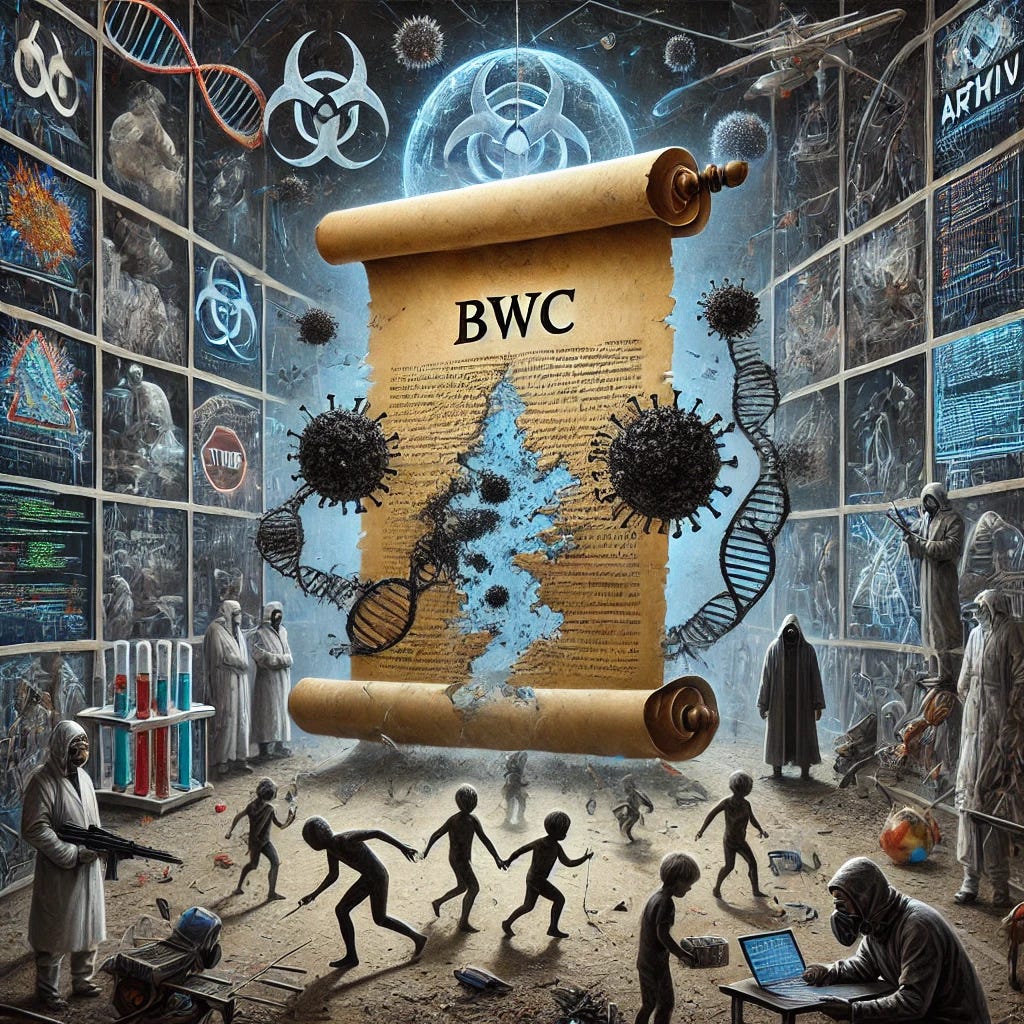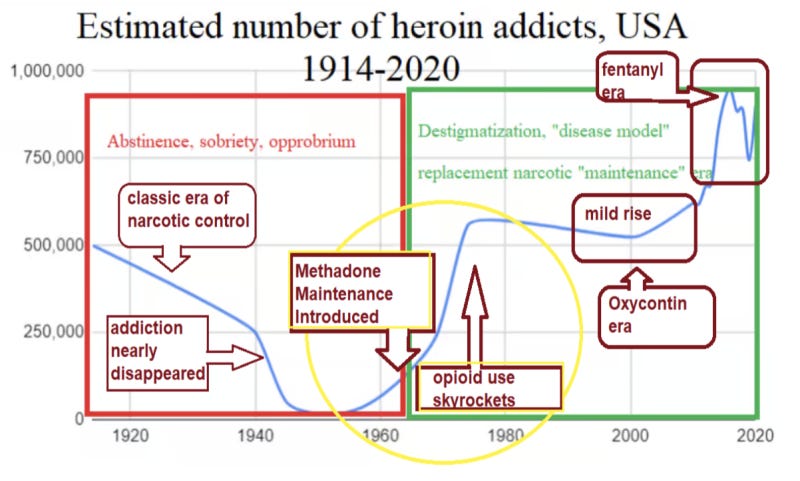BioWeapons, Unconventionally
Global-Control Whack-a-Mole?
| RANDALL BOCK APR 19 |
The United Nations Office for Disarmament Affairs’ 1972 Biological Weapons Convention (BWC) has 188 States Parties— and nine outside the BWC: four states in limbo (Egypt, Haiti, Somalia, Syria) and five non-signatories (Chad, Djibouti, Eritrea, Israel, Kiribati). This document didn’t prevent Iran and Iraq’s lobbing bioweapons at each other in the 1980s; Russia’s targeted political bio-agent poisonings; nor Syria’s chemically attacking its own, 2010s. Control’s an illusion—treaties don’t kill intent or capability.

History agrees. Look at U.S. narcotics from 1920 to 1965: prohibition didn’t eliminate drugs, but it kept use low. Then we medicalized addiction, rebranded users as patients, and demand exploded. A vast opiate-hunger’s incentivizing Fentanyl-smuggling is our reward.

Grand schemes don’t fix root causes; they backfire. The War on Poverty threw cash at need, but people adapted—gaming the system became the game. Gun control? Gangs still shoot. The BWC’s another noble façade, a paper wall against a world that laughs at rules.
Rewind to the Cold War. In a bipolar world—U.S. vs. Soviets—the BWC had more bite. Fear of the U.S. kept many in line, while Soviet alignment shielded others. Ken Alibek, a top Soviet bioweapons scientist who defected in 1992, revealed how vast their program really was: two systems—one he helped dismantle, the other, run by Russia’s Ministry of Defense, left intact.

He warned that Russia never stopped, instead diving into genetic manipulation—signaled by Putin in the early 2000s and echoed in recent accusations against Ukraine. Treaties mean nothing when capabilities persist. Today, we’re overextended and strapped for cash while rogue states catch up fast. AI and open info-sharing—GitHub, arXiv—flatten the playing field. Compliance is obsolete; it’s whack-a-mole without a referee.
This is exactly the concern echoed in a 2023 future-planning study by the U.S. Marine Corps. It identified cutting-edge biological applications—genetic engineering, synthetic biology, and CRISPR gene editing—as some of the most disruptive and dangerous dual-use technologies on the horizon. CRISPR, in particular, is a game-changer: cheap, precise, and accessible. It allows live genomic editing in bacteria, viruses, fungi, plants—even humans. Synthetic biology pushes further still, with the first fully artificial bacterial genome created in 2019. What once took years in military labs can now be built from a desktop and a DNA printer. With synthetic life on the table, biological weapons become modular, programmable, and disturbingly democratized.
China, according to U.S. intelligence assessments, continues to blur the line between civilian biotech and military ambition. Presentations from Chinese military medical institutions reportedly explore, identify, and test numerous toxins with potential dual-use applications. The United States has explicitly accused China of failing to distance itself from weaponizable biotech. Add North Korea, Iran, and an unrepentant Russia to the mix, and the idea of a globally enforceable ban begins to look delusional.
Syria refused to ratify and already has a history of chemical and biological attacks. Israel, a non-signatory, faces existential threats. Signing the BWC while Syria shrugs would be like locking your door while the arsonist roams free—especially after October 7, 2023’s literal playing out of that analogy. Iran signed, but taqiyya invites deception; its nuclear program tells the story. China signed too—but Wuhan’s SARS redux speaks louder. It’s bait-and-switch: we chase signatures, they chase capability.
Worse, we’ve outsourced biodefense to partners like China and Ukraine via groups like EcoHealth Alliance. We poured USAID cash into countries we assumed would play fair. While we debated gain-of-function semantics, China mastered the technique—and may lead this tech race, as happened with cars. Ford and GM entered China thinking they’d struck gold. Beijing reverse-engineered their playbooks, undercut them, and waved goodbye with a smirk. That happened in public—why expect anything different in secret labs?
Grand strategies fail when execution is uneven. ASPR and BARDA embody this: bloated bureaucracies that slow U.S. biodefense while adversaries push forward. Since 1972, the BWC has banned lethal bioweapons research—hamstringing our ability to develop countermeasures. Our adversaries don’t care. Think SALT, or the Paris Accords: we step back, they sprint ahead. Now we settle for treaty-compliant “non-lethal” viruses that disable, not kill — half-measures in a (war-)game designed to be lost.
The UN? Useless. Morally bankrupt. It churns out resolutions against Israel—a functioning democracy—while brutal regimes that imprison dissidents and crush minorities skate by. USAID mirrors that hypocrisy: we fund, they pretend to reform, the UN looks the other way.
Alibek’s take on COVID-19 resonates—our containment model is too slow, too rigid. But where does this leave us? No treaty at all? The BWC tasks signatory states with self-enforcement – undoubtedly akin to O.J. Simpson’s vowing to find Nicole’s killer.
Ditch the treaty? It’s difficult to recommend that, but certainly we should have vigilance and skepticism that many others have already done it, despite external façades.
The good news? We’re not stuck in the “old days” of rigid vaccine stockpiles—prevention’s the play, not proliferation. mRNA tech can churn out vaccines fast—COVID proved it—but the rollout flopped, awkwardly timed after SARS-CoV-2 peaked, peddling an antiquated jab for a virus that’d already left the stage, risks with dwindling benefits. Still, with CRISPR, synthetic biology, and genetic tricks, we could mix-and-match smarter: a diffuse nationwide network for just-in-time vaccine and therapeutic production, tailored to active, severe threats—not blanket shots for ghosts.
Stockpiles still matter—but not for vaccines. Think treatments—ivermectin, once sneered at by the CDC

—antivirals, antibodies, anything to blunt the edge while we scale up.












